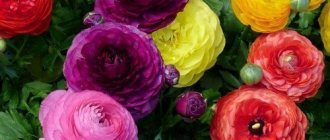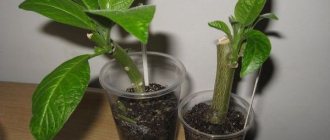Author: Elena N. https://floristics.info/ru/index.php?option=com_contact&view=contact&id=19 Category: Garden plants Published: January 31, 2019Last edits: January 20, 2021
- Rules of care
- Buttercup (Ranunculus aconitifolius)
Did you know that cut buttercups last for up to two weeks without losing their freshness? And the fact that they have poisonous juice? In Shakespeare's tragedy, the potion that plunged Juliet into a death-like sleep was made from buttercup. Garden buttercups no longer resemble their wild relatives: breeders have created cultivars, densely double flowers that are more reminiscent of rose buds than species flowers. This is why ranunculus is so in demand among landscape designers and florists.
- How to grow buttercups from seeds?
- How to choose a place for them in the garden?
- How to care for ranunculus throughout the season?
- What to do when the buttercup fades?
Read about it in our article.
What does ranunculus or buttercup look like?
Although, perhaps, every person has heard about buttercup, not everyone knows its description.
Ranunculus is a real flowerbed decoration
Which family does it belong to?
Buttercup (ranunculus) is part of the Buttercup family, which, according to various sources, includes from 1200 to 2000 different plants. Representatives of this family are found in almost the entire northern hemisphere - from temperate latitudes to the Arctic. Moreover, in these parts you can see about 13 genera of flowers!
Briefly about the history of appearance
Ranunculus are flowers that have been well known to mankind for thousands of years. Even in the works of the ancient scientist Pliny there are references to this elegant plant.
This is interesting! From Latin, the name of the flower is translated as “frog” - and all because it is often found on swampy soils.
Initially, its homeland was Iran and Syria, but over time it became popular among Europeans, and then spread throughout Europe. Later it went out of fashion, but in recent years florists have become interested in it again and are actively developing new varieties.
Plant characteristics
This is a fairly extensive genus, so the flowers in it differ greatly from each other.
On average, their height ranges from 20 to 80 cm. The plant grows well both in pots and in open ground. The shoots are very similar to dahlias - both stems and leaves. The roots have an interesting shape - they look like crow's feet.
The flower is perfect for bouquets
When the flower just begins to open, it looks like a rose. Well, fully opened buds look more like an elegant poppy. The similarity is enhanced by the color - most varieties have deep orange or red flowers.
On a note! Some types of ranunculus are used in folk medicine to treat skin diseases.
The plant is perennial. That is, having planted a tuber in the garden once and creating optimal conditions for growth, a flower lover can be sure that every year the plant will delight him with gorgeous blooms.
Growing plants
Remove the film or glass from the containers as soon as the first sprouts of buttercups appear. From this moment, the temperature for the plant is increased, but to restrained room values: about 18 degrees (it should not fall below, but values above 22 degrees are not welcome).
An important condition for the normal development of garden buttercup seedlings is supplementary lighting. The daylight hours for this plant should be increased to 10 hours. Under conditions of warm spring and favorable weather, buttercups feel good in a south-facing window, but with additional lighting they develop better and do not stretch out as much.
Seedlings of Buttercup, Ranunculus
Classification of ranunculus species
Calla flowers - growing and care at home
It is impossible to list all types of plants in one article - their number exceeds four hundred. But the most interesting ones are worth considering.
Asian group
Asian buttercup is a very beautiful plant. This is a herbaceous perennial 40-45 cm high. The stem can be either straight or branched. The leaves are covered with elegant down. The flowers are medium-sized - from 3 to 5 cm, and they will delight the grower with a rich range of colors: orange, pink, yellow, red.
Persian group
Externally, Persian buttercups are similar to Asian ones, differing only in flowers and stems. The latter are quite short. But the flowers are very elegant - they are found with both simple and elegant double petals.
French group
These plants are of medium height and have distinct bare stems. The flowers are semi-double, with fluffy petals giving them a ball shape.
African group
They are also known as turban-shaped ones. They can boast of the largest flowers - spherical, densely double. It is not surprising that many gardeners prefer them.
Botanical description
The garden buttercup flower is a herbaceous perennial plant with an average height of 65 cm. Its rhizome is tuberous, fleshy, the stem is leafy, branched, the leaves are trifoliate, similar to dahlia leaves, flowers with a diameter of 8-10 cm are simple, double or densely double in bright colors: purple, white, salmon, pink, red, orange, cream, yellow - many shades, in addition to blue and blue, there are two-color varieties. They retain freshness for a long time when cut - at least a week. But despite all these advantages, the buttercup flower is poisonous, so keep it away from children and pets.
Varieties that are most popular with gardeners
Amaryllis flowers - home care
Florists have developed hundreds of varieties of the flower. The most interesting varieties:
- Bloomingdale's. A miniature plant, perfect for growing in a pot. The height is about 25 cm and large flowers distinguish it from a number of numerous relatives.
- Color Carnival. Very tall plants - up to 70 cm. Double flowers, of different colors - from yellow to dark pink. Perfect for making elegant bouquets.
- Superbissima. Another variety intended for cutting. The stems are long and the petals are semi-double. This variety contains white and red ranunculus.
Top dressing
The plant needs to loosen the soil. Fertilizers should be applied in a timely manner to obtain lush flower beds. It is better to fertilize once every 2 weeks with potassium fertilizers.
If there is a lot of nitrogen in the soil, then intensive growth of green mass will be observed. A little lime is added to the soil to reduce its acidity.
Gardeners choose vermicompost to ensure lush flowering. If you add this fertilizer to the soil, the buttercup will be less susceptible to diseases. The decorative effect of the flower also increases.
How does ranunculus reproduce?
Gloxinia flowers - home care
To figure out how to plant ranunculus, you should learn about the methods of its propagation, as well as study the theory.
Growing from seeds
This option is more common - seeds are usually easier to acquire than bulbs. But you will have to wait much longer for the first flowers - several months are lost, so in the first year when grown in open ground you may not see them. Therefore, experts recommend using seedlings.
The variety of cultural shades is amazing
Time to board
The optimal time for planting is mid-February. Then, by early to mid-May, the seedlings will have grown and become strong enough to be planted in open ground.
Selection of capacity
The root system of buttercups develops quite quickly, so a pot or other container needs to be quite large and deep. It is important not to forget about drainage at the bottom and holes for draining excess water - otherwise the roots will begin to rot.
Preparing soil and seed
The optimal soil is obtained from soil and peat - they need to be taken in equal proportions. It is advisable to use soil from the area where the flowers will grow in the future, so that they immediately get used to it.
On a note! When growing crops in flowerpots, you can plant up to five plants together - they will form a beautiful bouquet.
First, the seeds are soaked in warm water, tinted with potassium permanganate for disinfection. The floating seeds can be removed immediately - they probably will not sprout. However, not all of those who remain will rise. Even under ideal storage conditions, germination rarely exceeds 30%.
Seedling care
15-20 days after planting, the first shoots will appear in the pot. They need to be covered with glass or polyethylene and protected from direct sunlight, sometimes moistening the soil with a spray bottle. The optimal temperature is from +18 to +23 degrees.
Dive and transfer
After throwing out the fourth sheet, you need to pick. The soil is abundantly moistened, the plants are separated and planted in separate containers. Peat pots are best suited.
Self-collection of buttercup seeds and their selection for sowing
You can get seeds from garden buttercups yourself even in the middle zone. But to do this, you need to leave the very first flower on the plant. The seeds will ripen only by the beginning of autumn. Since buttercups scatter seeds very easily, it is better to tie the seed capsule with gauze in advance. One box contains up to 500 seeds.
They must be dried, sorted into small batches and stored in separate containers or paper bags. The storage conditions for buttercup seeds are similar to the ideal conditions for tubers: from 10 to 15 degrees Celsius, in a dry room and with frequent ventilation.
For buttercups, it is very important to use fresh seeds collected from the previous season. They quickly lose their viability and the less they last, the better. When purchasing, carefully check the collection date. Seeds marked F1—hybrids with increased endurance—have a higher percentage of germination. The seeds on the market have a wide range in price, and the best buttercups are not always the most expensive.
You should always focus on the completeness of the information: even plant seeds that are not labeled as hybrid varieties, if you buy them from a trusted manufacturer who provides complete information about sowing dates, preferred agricultural technology and cultivation characteristics, are better than seeds from a company unknown to you.
When purchasing or collecting seeds yourself, you should take into account that about a fifth of the seeds, and sometimes more, give an unexpected color when growing and flowering. The variety of buttercups and the opportunity to obtain unique color variations are considered one of the main advantages of the seed propagation method of this plant.
Shoots of garden buttercup, Asian
Features of garden care
Growing a ranunculus flower in open ground, planting and caring for which is not difficult, still requires some mandatory procedures.
What conditions do buttercups like?
In order for a plant to grow actively and begin to bloom as quickly as possible, it needs soil with the following characteristics:
- neutral pH;
- fertile (chernozem or sandy soil mixed with compost);
- well drained;
- light.
What is the plant afraid of?
It is not enough to know how to plant buttercups with roots - it is equally important to have an idea of what conditions are not suitable for them. The plant really does not like heavy loamy soils - on them the root system receives little air and begins to rot.
Ranunculus tubers
Watering
The crop needs to be watered often, but little by little. Usually it is enough to moisten the soil from above, but on hot days watering should be more abundant.
Mulching
Suitable materials for mulching would be pine or leaf humus. A thick layer is not needed - 2-3 cm is enough.
Loosening
In order for air to pass freely to the roots of the plant, it is necessary to regularly loosen the soil. This is true for medium soils. On light, sandy soils, you can do this once or twice a season, for example, in the spring and before flowering begins.
Feeding
From mid-May to mid-June, you need to feed them every two weeks with nitrogen fertilizers, and during flowering - with phosphorus-potassium fertilizers.
Transfer
To do this, you need to dig up a piece of earth about 30x30x30 cm in size and, together with the plant, transplant it to a new place, after which the crop is abundantly watered and mulched. If everything is done correctly, then the buttercup will not even hurt and will immediately begin to grow.
A worthy decoration for a windowsill
Soil and containers for sowing buttercups
Garden buttercups can be sown in the soil, but only in greenhouses or greenhouses (and even then, anyway, for seedlings). Therefore, this plant is much easier to sow directly into containers. In both cases, the soil should be light, loose, loose, and nutritious. You can use universal soil for seedlings, but you need to make sure that it has a neutral pH.
Before you start sowing, the soil must be disinfected. For buttercups, a solution of foundationazole is often recommended, but treating the soil with a weak solution of potassium permanganate and regular scalding are also suitable.
Buttercup seeds can be sown both in special seedling boxes and in ordinary containers. The containers should be deep enough, but buttercups do not have strict requirements for the height of the soil layer. Sowing in large boxes that can be dug into the soil and taken out into the garden in the first year is also productive, avoiding diving and planting in the soil, thereby providing a more stable environment for the plants.
Possible problems in growing
When growing ranunculus, difficulties may arise for which you need to prepare in advance.
Pests
The most common problems are caused by spider mites, slugs, aphids and snails. The means of control are standard - preparations for them can be bought at any flower shop.
Diseases
Of the diseases, buttercups are most susceptible to powdery mildew and fusarium wilt. The problem is solved with the help of special fungicidal preparations.
Signs of improper care
In general, ranunculus is a rather unpretentious plant. The only thing he doesn't tolerate well is elevated temperatures. With it, it grows slowly and sometimes stops blooming.
Picking seedlings and caring for young buttercups
Young buttercups are transferred to individual peat pots, to a greenhouse bed (a greenhouse will do), to large boxes or to permanent containers with a large distance between plants only when they produce the third pair of true leaves. When planting in greenhouses or large containers, a distance of about 10-15 cm is left between plants. If buttercups are grown in boxes buried in the soil, then after the fifth and sixth leaves are released, they are simply transplanted to a permanent place, without diving.
Cleaning for the winter
Tubers are dug up from late August to September. During this period, the plant had already bloomed and the leaves began to die. The fragile root system must be handled carefully to avoid damage. It is also necessary to clean the tubers from soil and wash them in a manganese solution.
Adult bulbs produce several children per season, which can also be separated for the purpose of propagating planting material. Next, they are thoroughly dried at room temperature and subsequently prepared for winter storage.
How Dahlias are stored in winter is described in detail in this article.
How to prune Fuchsia for the winter is indicated here in the article.
How to grow a Wisteria plant from seeds is detailed in the article here: https://2gazon.ru/ozelenenie/derevo-i-kust/tonkosti-uxoda-i-vyrashhivaniya-glicinii.html
Reproduction methods
These decorative flowers can be propagated in two ways: tubers and seeds.
Propagation by tubers
This method is the simplest. To implement this, you will need to dig up the tubers before the onset of frost. Next, they are carefully cleared of soil, and the children are separated. In one season, a tuber can form up to 7 children. After separating them, it is important to treat them with a fungicide.
The treated bulbs are placed in a box or other container and covered with sand (peat). To store them, you need to choose a cool room with a temperature range from +5°C to +10°C, where they will be stored until spring. Such a place could be a basement or cellar.
Another way is to save planting material. It involves drying the tubers for 3-4 weeks, after which storage in room conditions is allowed.
During the winter, the bulbs can be damaged by fungus, so it is necessary to inspect them at least once a month. Minor damage is treated with brilliant green. If the plant is severely affected, it is removed from the box and the sand (peat) is replaced with a new one. These steps will help protect the rest of the plants.
Propagation by seeds
Buttercups can be propagated by seeds, but getting them yourself is a rather labor-intensive process. They quickly become sterile, and only a small number can remain viable. It is much easier to purchase high-quality seeds in a store or market that specialize in decorative flowers.
Origin story
In Latin, the name "ranunculus" means "little frog". It probably appeared due to the growth of many plant species near water. Buttercup oil has its own characteristic yellow tint, familiar to everyone from childhood. In fact, it is poisonous and tastes terrible, which is why no cows or other livestock eat it. Appreciating the beauty of this flower, herbalist Gerard wrote enthusiastically about it back in 1596. It is believed that the first buttercups arrived in Britain with Huguenot refugees from France some 20 years ago before Gerard's records.
The plants are quite hardy and will easily tolerate almost any soil that is not waterlogged. They are resistant to both open sun and shade. In May, when these bright flowers light up a dark corner of your garden, you will understand why refugees from France, although worried for their lives, stuck around and dug up the buttercups to bring back to England.











